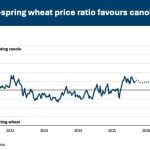More than a dozen U.S. ethanol plants are idle, with almost two billion gallons of production capacity producing nothing.
Ethanol giant VeraSun Energy Corp. has filed for bankruptcy protection and plans to soon sell seven of its plants to raise cash so that it can stay alive.
But no one should write off the ethanol industry or the demand for corn that it represents, says analyst Mike Krueger.
Most of the problems in the U.S. industry are due to financial incompetence, not production or market problems. He said most of the idled capacity will likely be back in production soon.
Read Also

Farmers urged to be grain-safe this fall
Working around grain bins comes with risk, from farmers falling to drowning in grain: Experts have five tips to help avoid grain-related accidents this harvest.
“You’ll have people pick up these plants at half price of what it cost to build them and put them back into production,” said Krueger, who oversees the hedging for a North Dakota ethanol producer and operates the Money Farm advisory service in Fargo, N.D.
“The (Barack Obama) administration, if anything it’s more supportive to biofuels than the last administration.”
In an interview at the Manitoba Special Crops Symposium, Krueger said that many people falsely attribute the bulk of the ethanol industry’s problems to a margin squeeze caused by falling oil prices and high ethanol production costs.
But, he said, most of the problems that have bankrupted biofuel companies come from poor risk management practices.
“When we ran into that period from last summer to today, when prices have just collapsed, they were long corn, unhedged on the ethanol and just took terrific losses.”
Krueger said many ethanol producers could not find veteran risk managers and had to hire relatively inexperienced people to hedge their exposure to corn and ethanol prices.
These risk managers, generally young, had not lived through the slumps like the one that has occurred since July 2008 and were not diligent in hedging for the risk.
Other companies got caught up in the commodity bull market atmosphere and assumed they didn’t need to hedge.
“For the first three or four years it was easy,” said Krueger.
“All you had to do was buy corn and if you waited a day, both the corn and the ethanol went up. Margins were good. The business was easy. People weren’t paying attention to risk management.
“But then you take $3 off the corn market and you have some real issues.”
Inadequate risk management practices have plagued companies throughout the world’s grain, food and energy industries.
Some, like the Canadian Wheat Board, are re-examining their practices because of big hedging losses in 2008-09.
But Krueger said some small U.S. grain companies and ethanol companies played a different game, where risk management was replaced by commodity price speculation.
Some companies began buying up grain in last summer’s commodity mania and storing it, in the expectation of higher prices to follow. When the market broke, they were long grain and often moved slowly to liquidate their positions.
Those two factors caused the epidemic of shutdowns in the ethanol industry.
Because various biofuel requirements in the United States have not been scaled back, there is still a big market for ethanol and production will likely come back sooner than people expect.
“The industry may not grow, but we already have enough plants to meet the markets,” said Krueger.















